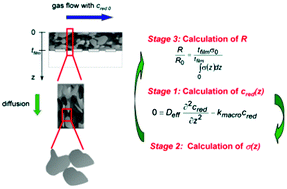Modeling of hydrocarbon sensors based on p-type semiconducting perovskites
Abstract
In the scope of the present contribution, perovskite SrTi1−xFexO3−δ was investigated as a model material for conductometric hydrocarbon sensing at intermediate temperatures between 350 and 450 °C. To explain the observations made during sensor optimization in a quantitative way, a novel sensor model was proposed. At the microscopic scale, the local gas concentration affects local conductivity of the gas sensitive material. In the case of n-type tin oxide sensors, this interaction is commonly attributed to a redox reaction between the reducing analyte gas and adsorbed oxygen. In contrast, a reduction process affecting the entire bulk was assumed to govern gas sensitivity of SrTi1−xFexO3−δ films. Although very few variables needed to be assumed or fitted, the present bulk-type model was found to represent well sensor functionality of p-type conducting SrTi0.8Fe0.2O3−δ films. In addition to the temperature dependence of sensor response, the hydrocarbon sensitivity, m, was predicted with good accuracy. The different sensor responses towards hydrocarbons with a different chemical reactivity and other cross-interfering species, such as NO, was explained as well as the dependence on film thickness for screen printed films.


 Please wait while we load your content...
Please wait while we load your content...